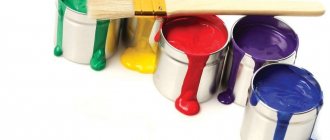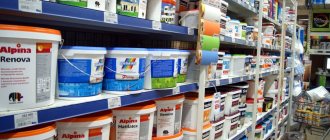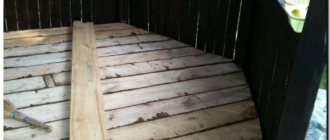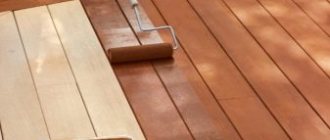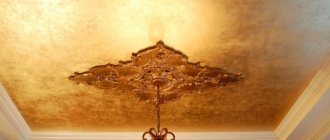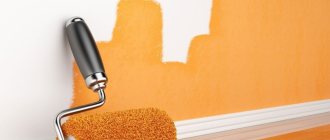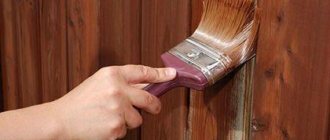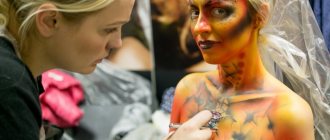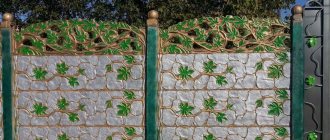The best airbrush paints: a review of popular brands
Airbrushing has come a long way from its invention to recognition as a painting technique.
Now the airbrush is an indispensable tool for creating illustrations on various materials. For this purpose you need good airbrush paints. How airbrushes are used in painting:
- cars;
- walls;
- fabrics;
- laptops and phones.
It is difficult to imagine nail art, as well as body art, without airbrushing. Photographers use this method for retouching photographs, artists paint paintings.
New types of dyes appear regularly, making it possible to achieve realistic paintings and even drawings in 3D images.
Principles of paint dilution
The paint should be diluted with exactly the solvent recommended by the manufacturer. This will allow you to achieve the best quality coating and avoid various problems. It is possible to achieve better results with other thinners, but this requires a lot of experimentation based on experience.
There are no exact recommendations regarding paint dilution: the material is diluted individually in each case. Carrying out this operation with your own hands will allow you to form an idea of the properties of paint diluted in various proportions, and act on this basis in the future.
During the dilution process, they are guided not by the airbrush model, but by the air pressure at the outlet. They operate on the principle that high fluid corresponds to low pressure.
Normally diluted material requires a pressure of 1.5-2.5 bar, and fine work is carried out at 0.3-0.5 bar. However, it is important not to overdo it, as excessively liquid paint will spray in a spidery pattern even at 0.3 bar.
There is a well-known rule according to which normally diluted paint has a consistency similar to milk. However, it must be taken into account that it applies only to PF enamels and NC nitro paints. This is not true for water-based acrylic.
Types of paints
The quality of paint in airbrushing determines the final result.
ATTENTION! When choosing paint and varnish products, be guided by the design of the airbrush and the diameter of the nozzle.
For artistic work, use an airbrush with a nozzle with a diameter of 0.2-0.3 mm. This suggests that not every material is suitable for them. Paints are divided into those that are suitable for airbrushing and those that are not suitable for working with an airbrush.
For example, gouache will not be suitable due to the size of the pigment particles. It will instantly clog the nozzle of the device. If watercolor paints were properly diluted with water, they could be used. But watercolor pictures quickly change color and become dull and faded. Therefore, they are used only for processing paper surfaces in interior design.
Fabric dyes are suitable for painting textiles such as silk or cotton. They are diluted with water by 20%.
IMPORTANT! To fix the design, the fabric should be treated with a hot iron.
For airbrush drawings on glass, stained glass varnishes and paints are used. It is necessary to thoroughly degrease and clean the glass without using fabric materials. The slightest speck of dust or thread will be visible through translucent varnish or paint. These products are diluted only with special solvents. And before starting work, check how the surface intended for processing will react.
Other paints suitable for airbrush
With special paints everything is clear. Here you need to choose only the most acceptable paint in terms of quality and price.
Another option is non-special paints, but suitable for use with an airbrush.
As mentioned above, airbrush paints must be thin and fine enough to be sprayed normally by the airbrush nozzle. It is necessary that the paints meet these parameters. It is not difficult to dilute the paint to the desired consistency. Typically, car paints are diluted 2 to 1 (2 parts paint to 1 part thinner). For use with an airbrush, the paint should be diluted more thinly, 1 to 1.
In addition, it must have a sufficiently fine grind and a sufficient concentration of pigment. That is, the paint after dilution should remain sufficiently opaque.
The paint should be diluted and the consistency should be similar to milk or ink.
Whether the paint will spray normally depends on the size of the nozzle of a particular airbrush. Some airbrushes come with different nozzle sizes designed for different consistencies and types of paint.
Paint and varnish materials for airbrushing
Acrylic and enamel materials have become suitable and frequently used dyes for airbrushing. Enamel products are sprayed thinner, since the pigment consists of fine particles.
ATTENTION! Due to the high cost of enamels, the best airbrush paints are acrylic.
They have the necessary properties:
- Environmentally friendly - non-toxic, odorless. No protective suit is required when working.
- Hypoallergenic.
- Fine atomization with nozzle diameters of 0.2 mm and above.
- Solubility in natural solvents and water.
- Dries quickly (2-3 minutes).
- Does not crack, remains bright for a long time.
- The finished drawing does not stain and cannot be washed by hand.
- Rich color palette.
- Easily washes off hands.
- When working with different colors, the paints do not mix to form dirty spots.
What paints to use with an airbrush for painting on cars?
Welcome to kuzov.info!
Let's look at the types of paints that can be used to paint with an airbrush on cars and motorcycles.
For use with an airbrush, the paint must be finely dispersed. This means that the size of the pigment in it must be small enough to pass freely through the airbrush nozzle. Ready-made paints for painting contain various additives (retarders/retarders and others) that allow the paint to be atomized and not dry out prematurely on the needle tip and nozzle.
Acrylic and urethane paints are most often used for painting on cars and motorcycles. We will also consider the use of nitrocellulose and alkyd paints.
When buying airbrush paint, you need to check whether the paint is suitable for the nozzle of your airbrush.
Popular brands of airbrush paint manufacturers
There is a large selection of paints and varnishes for airbrushing on the market. Leading brands produce products in this segment:
- Createx's Wicked paints are expensive, but they are a material for professional use. Highest adhesion gives durability to the image. These bright colors work on any surface;
- Createx AirBrush and Auto-Air are a product of the same company Createx, but a little cheaper. The consistency of the dye is more liquid, with slightly larger pigment particles than Wicked. Ideal for amateur work, as the quality is close to professional brands;
- ExMix paint is a water-based polyurethane paint from a Russian manufacturer, which compensates for a rather limited palette with its affordability - 100 ml for 300 rubles and its versatility;
- Airbrush Sector is a reputable brand offering products for not too expensive airbrushes;
- Pro-Color is a company that sells a wide range of budget options. Economical, but also of appropriate quality;
- Policolor, produced by the Italian company Maimeri, is distinguished by its affordable price, choice of colors and thick consistency. This paint is carefully diluted for ease of work, then it lasts for a long time. The nozzle of the device is at least 0.3 mm. Used for canvas painting, wall painting, paper, wood, cardboard;
- Sp-nail Color acrylic dye is often used to apply designs to nails. The product is ready for use, mixes, forming overflows;
- House of Color is a US company that offers products that create error-free coatings. The prices will please the craftsmen;
- For airbrushing, Classico oil paints produced in St. Petersburg and Nerchau from Germany are used. Dammar varnish is used to fix the image. And the material itself is diluted with turpentine or white spirit;
- Sp-Tattoo Color is a non-toxic product, easily soluble in water. Used for body art. You can keep it on your skin for three days and on your nails for seven days.
Let's sum it up
You can find effective products on the paint and varnish market to perform any complex tasks. Experienced painters will advise you on paint whose properties are as similar as possible to standard car enamel. But in this case you will have to deal with drips and other troubles. Choose specialized acrylic that will help you get rid of standard troubles during the operation of a painting tool. This will make your airbrushing experience more enjoyable and easier.
It is especially important to choose good materials for an airbrush when it comes to starting out. From the very start, you can discourage the desire to engage in this undoubtedly interesting and profitable business if you choose the wrong set of products. Please note that each manufacturer has its own set of advantages and disadvantages; all reputable brands supply instructions for their preparation with the materials. Information can also be obtained on the official websites of brands. In any case, when choosing, always rely on the opinions of professionals and your own experience.
Food coloring for airbrush
Special airbrushes are used in the production of confectionery products. Inscriptions and drawings are applied with food-grade paints that do not impart foreign odors or tastes to the products. Concentrated formulations color sweet masterpieces in bright shades. Dyes that produce pearlescent or metallic colors are used. When mixing, confectioners achieve brightness for:
Using stencils, drawings are applied, even portraits of people.
They produce food paints for airbrushes in bottles that are easy to store. The AmeriColor brand is popular among confectioners.
Coloring stages
Of course, the process of applying paint to the prepared surface occurs in stages. There are five of these stages in total.
- Selection of sketch. You should come up with a drawing or choose it from thousands of available sketches. It is important to model how it will look on the surface, take into account its size and content so that it fits into the context without violating the integrity and composition. Next, the drawing is transferred to paper.
- Preparing the area for painting work. Everything here is quite simple; it is important to make sure that everything that may be needed during the work process is at hand. In some cases you will have to act quite quickly. You should purchase products to eliminate smudges in advance.
- Selection of paint. A very important stage on which the brightness, saturation, structure and durability of the drawing will depend. Don't skimp when choosing paints.
- The process of applying paint to a prepared surface. If all requirements are met, you can begin painting.
- Drying and fixing the material using varnish. After painting, when the surface is ready for application, additional processing is carried out. Varnishing gives the picture a finished look. The work acquires a glossy structure and retains its properties for a longer period. However, varnishing is not carried out in all cases.
Most often, metal body parts come in the so-called. transport soil. It has a rough texture and external damage, so it needs to be removed first. Further coverage:
- polish;
- wash;
- dried;
- degrease with white spirit.
If all of the above types of work have been completed, you can proceed directly to application. In some cases, the painting process also includes tinting. Tinting is the creation of halftones when applying a paint material to a substrate. This effect is achieved by mixing paints of a certain type and composition. Tinting allows you to create not only shades, but also transitions, which is extremely important when working with an airbrush. The only drawback is the complexity of the process itself. Tinting requires significant skills and experience from the artist.
Airbrush paints
Hi all!
Today I’ll tell you a little about airbrush paints, what they are.
Actually, there are a huge number of these paints, different manufacturers, different quality, etc. They are mainly divided into two types: water-based (acrylic type) and solvent-based (nitro paint).
Nitro enamels - their main advantage is that they dry instantly on the surface, and they have a very fine grind, but a huge drawback is the smell
If you can work a little with paints on water without a respirator, then with nitro it won’t work that way)) I once painted all day with nitra without a mask, then I staggered all evening.
Specialist. airbrush paint - takes a little longer to dry on the surface, has a little more pigment than nitro paint, but definitely doesn’t stink
The question immediately arises: What is the difference between ordinary acrylic and water-based airbrush paint? — The airbrush has a very small nozzle (the hole from which the paint flies))), so ordinary acrylic needs to be very diluted with water so that it gets through the airbrush, and this helps to reduce the hiding power of the paint. in general, airbrush paints have a very fine pigment; they do not need to be diluted much (although it all depends on the manufacturer
) - this is kind of the main difference + there are a lot of technical subtleties, but I won’t dwell on that.
There are many types of airbrush paints, depending on where and how they are used) Let's go in order:
Opaque (Regular opaque paint) - allows you to quickly pick up color and overlap layers.
Transparent (Translucent paint) - usually this paint is used after the drawing has already been drawn in white.
Candy (lollipop effect) - they are completely transparent, so they are applied on top of a white design.
Fluorescent (glows under UV light) - this paint comes in different colors, and it should be applied to the light areas of the picture, so the glow will be better.
All sorts of metallics and flakes - like paints with sparkles
..mainly used in custom painting of cars, motorcycles and accessories.
These are the main types of paints for airbrushing. There are a bunch of different application methods, all sorts of tricks, etc. Each manufacturer has its own tricks)
The paints that are produced in Russia are eXmix (water-based) and Air Master (solvent-based) that I know of. I tried both, they are not bad enough)) There are also paints from foreign manufacturers, such as: Hansa Pro Color (Germany), Auto Air Color and Wicked Colors (both from Createx Color - USA), GOLD (USA), Iwata (Japan), Vallejo (I think also the USA)), etc. ..a lot of them))
All these paints are suitable for almost any surface. The only thing about textiles is that not everyone draws) or rather how they draw, but after washing everything goes away
I tried a lot of different paints, but settled on Wicked Colors paints - they have a very fine grind and quite good hiding power, in short I like
You can talk about helmets for airbrushing for a very long time, and every hour you remember something new
. I think I talked about the main types of paints and their applications. If anyone suddenly has specific questions, write them in the comments, I will answer
Airbrush paints. Useful tips for work
Some useful tips (it’s a pity that I didn’t come across it anywhere earlier, I learned from my mistakes), well, maybe it will be useful for someone.
The paint can and should be diluted with water (solvent) to a milky consistency. And even to the consistency of thin 10% sour cream - for me, in any case, this problem passed.
The airbrush must be washed with water before each color change (and so lazy!), and when using special paints - with appropriate cleaning solutions or solvents. You can only leave paint in the airbrush container for a short time.
The “golden” rule of airbrushing is to start and end with “air”. First open the air valve by pressing the button down, then gently pull it towards you to supply paint. Never start a job by feeding paint. those. Do not pull back the control button. without drowning her down. Otherwise, the paint will collect on the tip of the needle and... when you apply air, the airbrush will make a blot on your work.
Never leave the airbrush without rinsing it thoroughly after using it.
Well, I also didn’t immediately get around to blowing through the airbrush from different sides. I washed everything with tap water.
And directly about the colors. I usually use decal ones for textiles, sometimes for batik. I tried Darwi TEX paint yesterday and really liked it. It has just the right consistency, like thin sour cream, so I decided not to dilute it - hurray! went. Moreover, pearlescent paint applied to both black and red, transparent, but gives a pearlescent glow. Price - for 30 ml - $3.3. I want to try an opaque additive for paints from the same company - as I understand it, it gives a rich effect so that you don’t have to apply several layers?
I use liquid paints for silk from Yavana and Jakard. I sprayed them on cotton knitwear and synthetics.
LADIES THANK YOU SO MUCH FOR SUCH AN INTERESTING TOPIC, I HAVE BEEN GOING TO BUY AN IROGROPH FOR A LONG TIME, BUT I STILL DECIDE. Can you tell me, if I buy an airbrush, which one is better, because they are different. I need it for home use.
In the spring I was puzzled by the same question. I spent two weeks on thematic sites and only then went to buy. To paint on fabric, I chose an airbrush from Paache, or rather, I bought a set: the airbrush itself, three needles of different diameters, a hose, two jars for paint and one funnel for paint, and all sorts of amenities like a brush for cleaning. The selection criteria were as follows:
1. independent double action airbrush (i.e. you can adjust the supply of both air and paint)
2. location of the paint container - I took it with bottom feed, because... You may have to draw on a horizontal surface, which is problematic if the container is on top and especially if it does not have a lid. And then the kit included a small funnel if you only need a little helmet. But there are subtleties here: if the compressor is weak, then lower supply is absolutely not an option. I also liked the two transparent paint jars in the set - you can see when the paint is running low. I thought that if the container was opaque and had a lid, then, being carried away by the process, you might not notice that the karska was running out, and it ends at the most inopportune moments.. But this is my subjective opinion :)
3. The set of needles really captivated me:) there are already three of different diameters, you can do everything: from painting large canvases to registering small details.
4. well, the most subjective thing is that it fits in your hand. As soon as I picked it up in the store, everything was mine.
5. Well, the price suited me. Paache produces not the cheapest, but not the most expensive models. I didn’t want to study in Chinese, although most people advise starting with them.
Although I bought the Aero in March, I’m only starting to use it now, because I haven’t had a compressor for a long time. In general, I would say that choosing a compressor is no less important (maybe even more, because without it, an airbrush is just a piece of hardware), especially if you are going to work at home.
Sorry for the many letters
